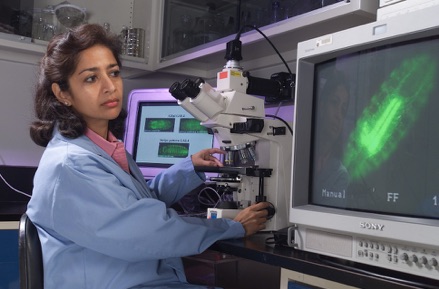
Innovator Sharmila Bhattacharya working in her lab at NASA's Ames Research Center.
I am a molecular biologist and I work as a scientist at NASA. I am interested in the biological effects of spaceflight and how we can facilitate long term human space exploration. We often need to study detailed molecular biological and physiological phenomena in genetically well-characterized small model organisms before we can develop and test potential therapeutics on humans.
Therefore, it is important to facilitate experimentation with small model organisms in space. It is for this purpose that the Compact Science Experiment Module (CSEM) was developed.
What does this invention do?
The Compact Science Experiment Module (CSEM) is a self-contained and automated enclosure for conducting science experiments in space and elsewhere. It is a 10 X 10 X 15 cm vented box (1.5 U cube) and contains an electronic processor that controls a video camera, lighting for daylight (white light) and night time illumination (infrared light) programmable in a circadian pattern, a fan for air circulation, environmental sensors to monitor temperature, % relative humidity, carbon dioxide and oxygen levels, and storage of data on board as well as the capability to downlink data by telemetry via interfaces such as the Satellite Tool-kit Ethernet Lab Like Architecture (STELLA).
Additionally, the CSEM contains one or more vented chambers that houses the experimental specimen and is located opposite the video camera which can therefore image the X and Y axes of the specimen chamber.
There is a mirror that is positioned at a 45 degree angle with respect to one side of the specimen chamber that allows the visualization of the Z axis of the chamber thus allowing a 3-D visualization of objects that may be moving within the experimental chamber. The CSEM uses only 3.2 Watts of power and operates at 5 Volts and is 1.4 kg in mass.
The CSEM has been used to conduct a fruit fly experiment on the International Space Station to validate the feasibility of housing and growing living organisms within this self-contained unit and showing the effective use of all of its designed capabilities including environmental monitoring, videography and data storage and downlink (AFEx experiment on SpaceX CRS-4 mission).
It was subsequently used by Airbus in Europe to fly a plant experiment to space for students in Germany.
What problem does this technology solve?
Experiments in space are almost always constrained by mass, volume, power usage, and by the limited time that the crew have to manipulate experiments. The CSEM is designed to be an automated enclosure that can house a variety of living and other experimental specimens, monitor the progress of the experiment automatically by videography and the environmental conditions via sensors, save or downlink all environmental and video data and yet occupy a relatively small volume, and have low power requirements.
These features make the CSEM useful, not only for spaceflight experiments, but also for other experiments that may have similar requirements such as those conducted in remote field settings, or are run untended for a period of time in laboratories.
Who else might benefit from this technology? What other applications do you envision?
Field studies conducted on the ground or in labs on Earth and in space often require automated function to reduce the time required to tend to long-term experiments.
These experiments also benefit from low resource requirements, such that smaller experiments that consume less power are often easier to sustain for longer periods in a cost-effective manner. The flexibility of the design of CSEM allows it to be used in different experimental settings and with different specimen types on Earth and in space.
Do you have any future plans to continue development of this technology?
We have already used CSEM successfully in two separate spaceflight experiments on the International Space Station. In each of these cases the specimen chambers were customized for either insect or plant experiments specifically.
This flexibility is intentionally built into the hardware design and allows for the accommodation of other types of experimental specimens (e.g. biological, chemical or other samples) in customized specimen chambers. This flexibility in architecture, therefore, leaves open the possibility of using the CSEM in the future on other space-based platforms such as the Lunar Orbital Platform Gateway, or for other Earth-based purposes.
Is there anything else you want us to know about your innovation?
The ability to video image the X, Y and Z axes to get a 3D visualization of specimen behavior and the movement of particles/specimen is a unique capability coupled with a vented habitat that allows for the growth of biological and other specimens, while monitoring and storing important environmental data, all enclosed in a footprint that is the size of a bread box.
Whom should I contact if I want to know more about this technology?
ARC’s Licensing Manager Antoinette McCoy.
Learn more about this technology here.



